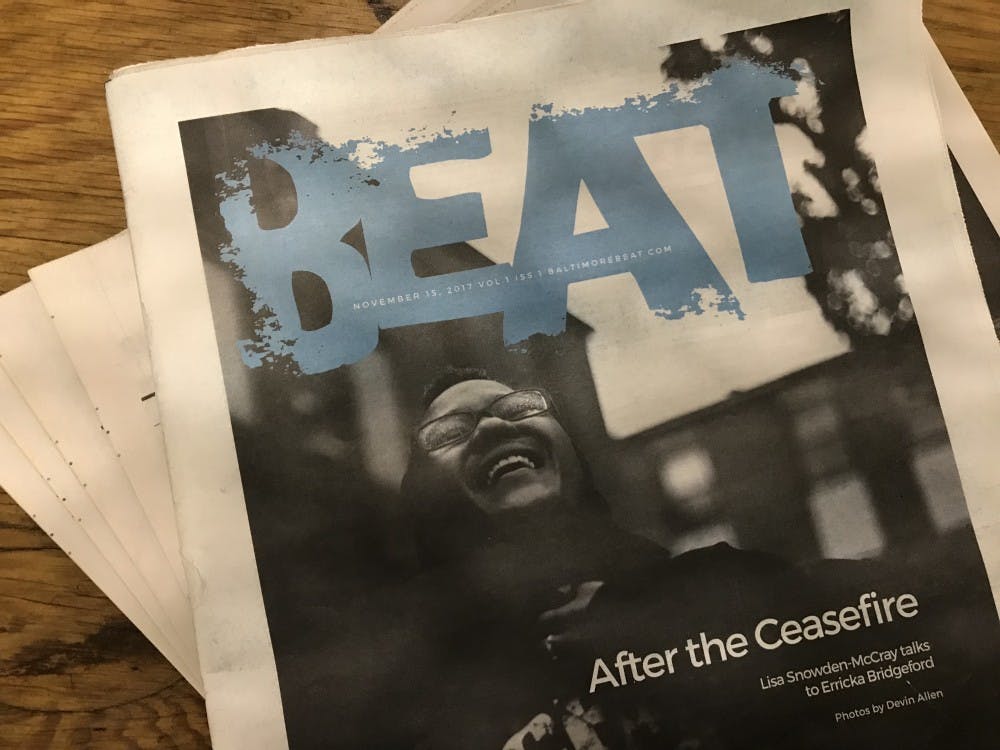The Baltimore Beat, the city’s new alternative weekly newspaper, debuted its first issue on Nov. 15. Covering politics, the arts, city life and more, the independent alt-weekly looks to be a reflection of the city, aiming to incorporate multiple community voices.
Baltimore’s previous alternative newspaper, The City Paper, which was owned by the Baltimore Sun Media Group, published its final edition on Nov. 1. After hearing this summer that The City Paper would be closing, Kevin Naff, a co-owner of the media company Brown Naff Pitts (BNP) Omnimedia, felt troubled by the loss of this voice in the city.
“As a longtime Baltimore resident, I was disappointed to hear that The Sun was closing The City Paper after 40 years, so we stepped in with a great team here to start a new alt-weekly, The Beat,” Naff said.
The Beat is owned by BNP Omnimedia, a company which also owns The Washington Blade, the nation’s first and oldest LGBTQ newspaper, and The Los Angeles Blade.
Naff began working at The Washington Blade in 2002 as managing editor, became editor-in-chief in 2006 and then part-owner in 2009.
Along with Naff serving as the publisher, The Beat team is made up of several local media veterans.
Jen Marsh, a 28-year City Paper veteran and former publisher, serves as associate publisher; former City Paper editor Brandon Soderberg is managing editor; former City Paper staffer Maura Callahan is deputy editor; Jeff Stintz, formerly of The Baltimore Business Journal, is the advertising director; and Lisa Snowden-McCray, formerly of The City Paper and The Sun, is the editor-in-chief.
“We have an experienced, top-notch team,” Naff said. “Additionally, I think it’s noteworthy and important that our editor is an African-American woman with an eye for ensuring our coverage is inclusive of the entire city we serve.”
Coming from a background of both traditional and alternative media, Snowden-McCray emphasizes creativity in telling stories. Embracing unconventional coverage of conventional journalism beats, like food or government, is part of why she is excited about The Beat.
“Watching the 2016 election play out, I really felt like a lot of the rules we adhere to when we think about traditional journalism don’t serve us well, and specifically don’t serve communities of color well,” she wrote in an email to The News-Letter. “For example, why must we give equal weight and coverage to hate groups? Why do we play along with the lie that we are neutral and objective?”
Naff said that despite having staff from The City Paper, The Beat is different from its predecessor.
“The Beat strives to serve a broader and more diverse audience, from African-American readers overlooked by mainstream outlets to the LGBTQ community, the Hispanic community, the Korean community and other underserved populations,” he said.
Snowden-McCray added that The Beat will mark a departure from the predominantly white male leadership of many alt-weekly papers.
“Obviously, I’m not either of those things,” she wrote. “Our deputy editor, Maura Callahan is white, but she’s a young woman. We both really want to make this paper as diverse and inclusive as possible.”
The Beat seeks to play a role in bringing the residents of Baltimore together to discuss the various problems facing the city, as well as promote the voices of the local creative community through coverage of the arts.
According to Snowden-McCray, the paper follows the tradition of a lot of alt-weekly papers in that it specializes in deep-dive news stories.
“For example, the Sun might have one story about the mayor’s crime plan,” she wrote, “but we’d later have a longer, more in-depth story about what that really means for people living under that plan.”
While Naff believes that The Sun plays an important and necessary role in the city, he said that in order to fully represent people in Baltimore, alternative media like The Beat needs a place.
“The Beat and other independent outlets are just as important to the lifeblood of Baltimore and ensuring everyone has a voice,” he said. “Real cities need these independent voices to hold our elected officials accountable and to cover underserved communities often overlooked by mainstream media outlets.”
Reading through the Nov. 29 Issue 3 of the paper, sophomore Madeline Stabinski shared her thoughts on The Beat.
“It’s definitely different from more mainstream newspapers,” she said. “There’s a lot more personal character to it, and it seems like it’s all about connecting with the local community, like the artistic voices and cool things going on.”
Stabinski also voiced her opinion that local media will always be in demand.
“Obviously people love the big media, and that’s what I think we interact with the most nowadays,” she said. “But people also always want to connect with sources that are closer to them and that they can relate more to on a local level.”
Senior Kailyn Fiocca discussed the importance of having media outlets like The Beat that express different perspectives.
“There’s always a need for publications that deal with things outside of what is conventional or normally covered in the media,” she said. “Niche voices have always been around and having places where they can be heard is important, especially in today’s climate.”
Naff encourages Hopkins students to be active members of the Baltimore community and to interact with the paper.
“They can learn more about the city,” he said. “They can contribute to the paper and site by reaching out with story ideas. We’re always looking for freelance writers and photographers.”
Snowden-McCray believes that The Beat can benefit the Hopkins community by helping it see life beyond the campus.
“For those students who are studying many of the issues that we work to bring attention to (housing, public health, criminal justice), it lets them see how they could use their degrees in the future,” she wrote. “For those studying writing, hopefully it’s inspiration that print is not dead and the craft that they are learning is still very important.”





